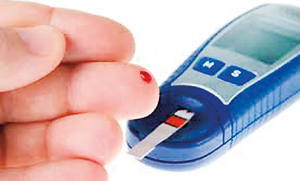Too much glucose in your blood?
As our test series continues, we turn once more to Prof.Shyam Fernando, a consultant physician and Professor in Medicine, to understand the workings of a blood sugar test. Designed to measure the amount of sugar or glucose in your blood, the test can provide a warning signal – high levels of blood glucose will eventually take a toll on several organs, damaging not only your eyes and kidneys, but impacting the health of your heart, brain and even your lungs. Join us this week as Prof. Fernando walks us through why the test is prescribed and how it’s used in diagnosis.
 What it is:
What it is:
Blood sugar tests measure the sugar known as glucose in your blood. Glucose comes from starchy foods (carbohydrates) you eat. The hormone called insulin helps the cells to use up glucose for energy production. Soon after eating, the glucose level in the blood rises. This increase makes the pancreas to release insulin, which pushes glucose into the cells and makes sure that your blood glucose level does not go too high. If the pancreas is not producing enough insulin or your cells are not ‘listening’ to insulin, your blood glucose level can remain high. This can damage your eyes, kidneys and blood vessels in the heart, brain and legs. This is what happens in diabetes.
How it is done:
All these tests are blood tests. A sample of blood will be drawn into a special tube after inserting a needle into a vein. Home blood glucose meters use blood drawn from a finger prick. This is called Capillary Blood Sugar or CBS.
How is it used in diagnosis?
RBS (Random Blood Sugar) is the commonest test done. This is done if diabetes is suspected (loss of weight, passing large quantities of urine) or to detect diabetes in seemingly healthy people (before insurance, visa applications, employment or planned surgery). RBS is perhaps the most convenient, because you need not fast for the test. RBS is usually less than 125 milligrams per decilitre (mg/dL). If it is high, you need to do a fasting test to check for diabetes. HbA1c, once in every 3 months is a must for all diabetics to check their level of control. HbA1c is also used to detect diabetes in healthy people.
Results of blood sugar tests are given in different ‘units’ which may be confusing. When you measure a distance, for example, you can express it in inches or centimetres, miles or kilometres. Likewise, these test results are expressed either as mg/dL (milligrams per deci litre) or mmol/L (millimoles per Litre). Depending on the unit used, the numbers differ.
An RBS of between 70 to 100 mg/dL is considered normal. A level of 126 mg/dL or above often means you may have diabetes. A level between 100 and 125 means pre-diabetes. If you are pre-diabetic you run a higher risk of developing diabetes (even heart attacks) later in life. So, this too should be taken note of. A HbA1c of 5.7% is normal. (Between 5.7 to 6.5 indicates prediabetes.)
How do I prepare?
As noted, there are several blood ‘sugar’ (glucose) tests;
Fasting Blood Sugar (FBS) test is done after an overnight (at least 8 hours) fasting. You are allowed to drink only water. This is the commonest test done to check whether you have diabetes. Two hour post-prandial blood sugar (PPBS) test is done two hours after a meal. In a diabetic on medication, this test is useful to find out whether blood glucose rises too much after a meal. Random blood sugar (RBS) test can be done at any time regardless of what time you ate. RBS does not vary very much in healthy people throughout the day. However, if it is too high, that might mean ‘trouble.’
Haemoglobin A1c (Heemo-globin-A-one-see) or HbA1c test measures how much glucose is stuck to red blood cells. If you are a diabetic, this is the best test to find out whether your diabetes has been in ‘good control’ for the last two to three months. Our target when controlling diabetes is to maintain the HbA1c around 6.5%. HbA1c test is also used to detect (diagnose) diabetes.
What are the after-effects?
None.
What are the pitfalls?
Sometimes, you cannot diagnose diabetes with just one blood test. So, if you have an abnormal blood sugar test, consult your doctor. If your RBS is over 200 mg/dl you may very well have diabetes, yet, it needs to be confirmed with other tests. HemoglobinA1c test, as mentioned earlier, gives a better idea of control in diabetics. An FBS test measures the level at ‘that particular point in time’. However, the HbA1c test tells you how your diabetic control has been during the past 2-3 months. Don’t rely on FBS test to check on your diabetic control.


